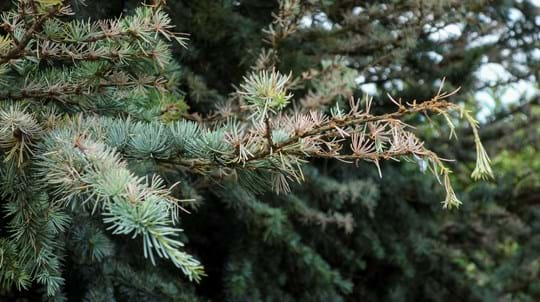
Pests and diseases
Sirococcus tsugae
A fungal disease that attacks cedars and hemlock.
Observatree Volunteer
In July 2015, at an Observatree training session held at Keele University, Barnaby Wylder (Forestry Commission) showed volunteers a 10-15 year old Cedrus atlantica glauca quite heavily infected with Sirococcus tsugae. The disease has been endemic in North America on Hemlock (Tsuga spp.) for many years but has only been observed in Europe, initially in Germany, in recent years.
The day after Barnaby’s talk I visited Attingham Park, very close to my home, and found tip die-back symptoms on 15-30 year old trees of Cedrus libani. Samples sent to Forest Research proved negative but within a month samples from three different Cedrus atlantica glauca at the National Sports Centre, Lillieshall Hall, all proved positive. Further samples collected from Shropshire and Mid Wales over the next two years also proved positive. This made me confident that I was able to detect the disease and no longer sent samples to Forest Research for analysis and confirmation.
By the end of August each year most dead needles in the infected area have fallen from the tip and so the infection is not so easily seen. However, by the end of June each year new symptoms begin to appear. I am lucky enough to have a 20-30 year old and a mature Cedrus atlantica glauca both infected with Sirococcus tsugae growing within 300 yards of my home, which allows me to study them almost on a daily basis. Last year I observed what I thought was new green shoots growing from what appeared to be the previous year’s infected shoots. I am interested to know if anyone else has seen this.
On a recent visit to Spetchley Hall gardens, near Worcester, I noted tip die-back symptoms on branches of Cedrus libani, Cedrus atlantica and Cedrus atlantica glauca but all were too high to sample. In July, at Croft Castle near Leominster and Cholmondeley Castle Gardens near Chester, I saw typical die-back symptoms on Cedrus libani. Samples of these were sent to Forest Research. At the latter I saw tip die-back symptoms on a few lower branches of a Cedrus deodara.